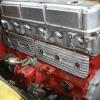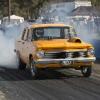202 harmonics problem
#26

Posted 16 March 2010 - 02:36 PM
#27
 _NZ Toranaman_
_NZ Toranaman_
Posted 16 March 2010 - 03:08 PM
You're going to weld it on?
Lol... Now I wouldn't put that past some people I have met
#28
 _70rey_
_70rey_
Posted 16 March 2010 - 03:45 PM
soon enough i will be going to a trimatic gearbox so this will only have to last me a little bit longer.
update so far is that we have decided to go up to 3/8 bolts on the flywheel and see if that will help for now, last time i pulled the flywheel off it had groves from the thread of the previous flywheel bolts. which leads me to believe that maybe they drilled the holes for the flywheel slightly to big allowing slight movement thus allowing bolts to come loose or snap.
ive often wondered about the balancer at the front but was told its a competition/race balancer and wasnt the problem.
hey nz toranaman how bad is your problem and how are you going to fix it if you dont mind me asking?
another question to those in the know will an automatic solve this problem. kinda hard to answer i know.
thanks for everyones input. kris
Edited by 70rey, 16 March 2010 - 03:47 PM.
#29
 _NZ Toranaman_
_NZ Toranaman_
Posted 16 March 2010 - 05:20 PM
hey nz toranaman how bad is your problem and how are you going to fix it if you dont mind me asking?
thanks for everyones input. kris
Im my case I drag race my little beast 100 races a year and the revs in the first 2 gears often go over 7000rpm in particular if I break loose off the line. On the street I wasted 2 pressure plates because of this so asked my local clutch shop to use 3x4 straps instead of the 2x4 to hold it on.
I broke a head off one stock flywheel bolt and then bought ARP bolts and used loctite last time but I think they have come loose again so this time have a simple fix thanks to an ex racer. I just rang him to double check before I said anything.
As well as the dowel he used lock-tabs, so this weekend my mission is to make a template and do them in pairs as well as loctite them. The engine was coming out anyway to throw on a borrowed fully rebuilt M21 and so I could check the bearings etc.
Edited by NZ Toranaman, 16 March 2010 - 05:21 PM.
#30

Posted 16 March 2010 - 05:27 PM
Try Holden bolts, nothing to lose?Ah OK, I started with ARP, but I really think the Holden ones have more bolt head to flywheel contact area, just my opinion,
Regards Simon
And this ^ ^ ^ is good reasoning.
I don't know if I would trust oldjohnno's advise too much.................................he makes thing up.
Edited by rodomo, 16 March 2010 - 05:39 PM.
#31
 _Bomber Watson_
_Bomber Watson_
Posted 16 March 2010 - 06:18 PM
Whether it will make a difference or not who knows.
Cheers.
#32

Posted 16 March 2010 - 06:31 PM
I think you should focus your attention more on controlling the vibration rather than just trying to keep the flywheel on. Even if you do get it to stay on I'm pretty sure that such severe vibration would just break something else.
Controlling the vibration on a Holden six requires pretty much the same steps as you'd follow with any engine. Firstly you'd want to run the lightest possible pistons and rods. Anything you can do to reduce the reciprocating mass in particular (eg. taper wall pins) will have a huge effect. A longer rod ratio also helps a lot though I doubt you'd want to change that now.
Next you'd need a much bigger and more effective harmonic balancer. It has to fit very tightly to work properly. Most balancers have a resonating frequency of their own and if it coincides with a resonant frequency of the crank then things turn to shit very very quickly. The bottom line is that if you're gonna spin it up then you need to be prepared to test a few different balancers to find the one that works best with your engine and rev range.
Also consider a heavy main girdle. It won't really do anything to stop the vibration directly but because the little Holden block is so light it wants to buzz along with the crank, and the heavy girdle might help dampen things down a little.
Don't get too distracted by the whole "balancing" business. When your builder tells you he's balanced your engine to within 1/2 gram it doesn't necessarily mean much. All it really means it that you can spin it up in the balancing machine without either or both ends wanting to jump out onto the floor. Your balancer can say it's "balanced" to within .000000001 grams, but that doesn't guarantee that certain areas of the crank aren't subjected to absolutely massive loads while the engine is spun up, due to the way the weights and counterweights are distributed along the shaft. What I'm saying is if your piston/rod weights match, and the assembly spins up ok on the machine, don't be too concerned with an inch/oz here or there. It's the least of your worries.
Definitely use a steel flywheel, for safety sake if nothing else.
A question for you guys: has anyone here had severe vibration problems with an automatic equipped engine? I've had flywheels come loose etc. but never had any dramas with flexplates or their bolts.. Makes you wonder whether the convertor isn't a pretty good damper in itself, and that in turn makes me wonder whether some sort of dampening elements on a manual flywheel would be of benefit?
hi Johnno, a mate has a fc with a 6/71 blown 202 and turbo 350, and hes shaking flexplates.
#33
 _Drag lc_
_Drag lc_
Posted 16 March 2010 - 06:42 PM
i wasnt going to post in here but couldnt resist.
if the guys can build it with 300rwhp they dont need any more help mate they will know how to sort this problem out.
#34
 _70rey_
_70rey_
Posted 16 March 2010 - 10:54 PM
ok 70 rey.,
i wasnt going to post in here but couldnt resist.
if the guys can build it with 300rwhp they dont need any more help mate they will know how to sort this problem out.
i see where your coming from mate but the guys that built my engine are no longer around here and id like to also see what other people have done to solve their problems. cant hurt wanting to know extra knowledge. and yeah i do wish the guys that built the engine were still around so i wouldn have to go to all this trouble asking people and making it sound like i know nothing at all.
#35
 _oldjohnno_
_oldjohnno_
Posted 17 March 2010 - 06:21 AM
hi Johnno, a mate has a fc with a 6/71 blown 202 and turbo 350, and hes shaking flexplates.
Interesting. Do you know what rev range he's running Kev?
#36

Posted 17 March 2010 - 07:30 AM
#37

Posted 17 March 2010 - 12:04 PM
hi Johnno, a mate has a fc with a 6/71 blown 202 and turbo 350, and hes shaking flexplates.
Interesting. Do you know what rev range he's running Kev?
it goes to 7500 i think
this is the car
Attached Files
Edited by greens nice, 17 March 2010 - 12:05 PM.
#38
 _threeblindmice_
_threeblindmice_
Posted 17 March 2010 - 01:13 PM
#39

Posted 17 March 2010 - 05:17 PM
Why didn't the Holden dealer team have this problem ? if they did how did they solve it ?
they wouldnt tell us their secrets even if they did, they were probably using cast iron flywheels anyways.
i wonder how harrop and jim rowly fixed the problem, they were both using steel flywheels
#40

Posted 17 March 2010 - 06:53 PM
Before you go to doing more radical things get under the car and before you pull everything apart put a dial indicator on the outer clutch face of the flywheel and get a mate to turn it over slowly by hand and check the run out in the flywheel. (Take the plugs out first it will be easier to turn over)
There are specs in the workshop manuals as to what the runout tolerances are but for what you are doing it should be absolutely minimal.
If the run out is excessive it could be one of two things either a warped flywheel or a bent/cracked crankshaft.
Once the runout has been determined
pull the flywheel off take it to the engine builder and get him to check it for warpness/bend.
being an ultra lightweight flywheel there is every chance that this could be warped due to high revs and heat.
If the flywheel is ok then it is further in the engine.
Next is to check the end of the crank for run out
If there is any/too much runout in the crank then that will be what is causing the bolts to break/loosen.
The cause may not be that it is out of balance but the fact that it is either bent or cracked.
I would suspect no 6 B/E journal allowing the flange end of the crank to bend if the problem is in the crankshaft
cheers
peter
#41
 _70rey_
_70rey_
Posted 17 March 2010 - 07:30 PM
the motor is basically brand new and the flywheel is lightened steel and has just been re-faced and balanced with the pressure plate and clutch.
we did notice however that there were thread marks on one side of the bolt holes in the fly wheel. this to us says that the holes in the flywheel were to big and were hoping that this was the problem. were are now going to 7/16 flywheel bolts and making the holes a nice tight fit.
#42
 _oldjohnno_
_oldjohnno_
Posted 17 March 2010 - 07:47 PM
we did notice however that there were thread marks on one side of the bolt holes in the fly wheel. this to us says that the holes in the flywheel were to big....
No. What it means is that it wasn't properly dowelled to the crank.
#43
 _rb3torana_
_rb3torana_
Posted 17 March 2010 - 08:09 PM
Now this come from experience with a flywheel coming loose too often in another car. We did almost all that you ahve done and found out that the crankshaft was cracked in No6 B/E journal and not far from falling apart with major consequences.
Before you go to doing more radical things get under the car and before you pull everything apart put a dial indicator on the outer clutch face of the flywheel and get a mate to turn it over slowly by hand and check the run out in the flywheel. (Take the plugs out first it will be easier to turn over)
There are specs in the workshop manuals as to what the runout tolerances are but for what you are doing it should be absolutely minimal.
If the run out is excessive it could be one of two things either a warped flywheel or a bent/cracked crankshaft.
Once the runout has been determined
pull the flywheel off take it to the engine builder and get him to check it for warpness/bend.
being an ultra lightweight flywheel there is every chance that this could be warped due to high revs and heat.
If the flywheel is ok then it is further in the engine.
Next is to check the end of the crank for run out
If there is any/too much runout in the crank then that will be what is causing the bolts to break/loosen.
The cause may not be that it is out of balance but the fact that it is either bent or cracked.
I would suspect no 6 B/E journal allowing the flange end of the crank to bend if the problem is in the crankshaft
cheers
peter
Mine did exactly that, huge crack in no6 bigend when I pulled it out, so I thought meh Ill give it a hit with a hammer, to my shock 5 hits and the crank was in 2. Scary s**t considering I was just turning it 7500rpm the day before I pulled it out. The main tell tale was not only the dial gauge on the flywheel face, but the rear main started to leak excessivly.
#44

Posted 17 March 2010 - 10:32 PM
Now this come from experience with a flywheel coming loose too often in another car. We did almost all that you ahve done and found out that the crankshaft was cracked in No6 B/E journal and not far from falling apart with major consequences.
Before you go to doing more radical things get under the car and before you pull everything apart put a dial indicator on the outer clutch face of the flywheel and get a mate to turn it over slowly by hand and check the run out in the flywheel. (Take the plugs out first it will be easier to turn over)
There are specs in the workshop manuals as to what the runout tolerances are but for what you are doing it should be absolutely minimal.
If the run out is excessive it could be one of two things either a warped flywheel or a bent/cracked crankshaft.
Once the runout has been determined
pull the flywheel off take it to the engine builder and get him to check it for warpness/bend.
being an ultra lightweight flywheel there is every chance that this could be warped due to high revs and heat.
If the flywheel is ok then it is further in the engine.
Next is to check the end of the crank for run out
If there is any/too much runout in the crank then that will be what is causing the bolts to break/loosen.
The cause may not be that it is out of balance but the fact that it is either bent or cracked.
I would suspect no 6 B/E journal allowing the flange end of the crank to bend if the problem is in the crankshaft
cheers
peter
Mine did exactly that, huge crack in no6 bigend when I pulled it out, so I thought meh Ill give it a hit with a hammer, to my shock 5 hits and the crank was in 2. Scary s**t considering I was just turning it 7500rpm the day before I pulled it out. The main tell tale was not only the dial gauge on the flywheel face, but the rear main started to leak excessivly.
I got a counter weighted red crank (a bloke made a few 25+ years ago) in a 202. Before i got it , it was in a mates XU1 that revved hard but he had alot of trouble keeping clutches & flywheels from coming loose. After many attempts he gave up & put a standard crank in it. The crank sat in another mates shed for many years till i got it, when i had my engine balanced (by Paul England i think in Melbourne) i was told the flywheel had 20 thou runout at the flywheel outer. This was put down to the welding of the counter weights & only grinding the main & big end journals but not the rear flange. Had it fixed & revved the crap out of it for a few years with no clutch/flywheel problems (20 years ago mine you). The motor is still intact as i built it ( now back in the same XU1) So this would have similar symptoms as a cracked crank but mine was fixable.
#45

Posted 17 March 2010 - 11:01 PM
#46
 _70rey_
_70rey_
Posted 18 March 2010 - 11:39 AM
the flywheel has not been dowled before.
we did notice however that there were thread marks on one side of the bolt holes in the fly wheel. this to us says that the holes in the flywheel were to big....
No. What it means is that it wasn't properly dowelled to the crank.
Do you know what builder/workshop did the crank for it? Not interested in tracking them down but I am curious
no i dont sorry mate. might be interesting to find out.
#47
 _oldjohnno_
_oldjohnno_
Posted 18 March 2010 - 12:29 PM
the flywheel has not been dowled before.
I see, I didn't realise you had no dowels at all... The bolts aren't intended to take any side load whatsover; they're only there to clamp the wheel hard up against the crank flange. And for light duty use the friction between the two faces is all that's needed. But if you push it hard or let it vibrate then there is movement between the crank and the wheel and it'll loosen (and eventually break) the bolts in no time. No amount of loctite or mechanical locking devices will stop this. The wheel has to dowelled on - and if you're gonna lean on it then you'll need at least two dowels to locate the wheel and stop it from working on the bolts.
The critical part is the fit of the dowels. The only really reliable way to do it is to bolt the wheel onto the crank and then drill and ream the dowel holes in both parts simultaneously. The dowels absolutely positively MUST be tight - they should be a tight tap-in fit at least. If you can start the wheel onto the dowels by hand they are too light a fit. When it's right the wheel will have to be pulled onto the crank with the bolts and it will be very difficult to get it off again without a puller.
If the engine is allowed to vibrate badly with the dowels then eventually the dowel holes will wear and so you'll lose the critical fit and then you're right back to square one. In this case all you can do is ream the holes for oversize pins to regain the fit. But whatever you do, I think controlling the vibrations is at least as important as using the right hardware to attach the flywheel.
#48
 _70rey_
_70rey_
Posted 18 March 2010 - 12:37 PM
for now what were are doind is to put 7/16 flywhel bolts in and to see if that helps first. i haven put the dowles in yet as i am going to an automatic very soon and then i shall put 4 dowles in. were hoping that the bigger bolts will have a better grab effect and will stop it for now but the car wont be driven hard at all. it is only so we can drive it and not allow the the car sit there till i can save money needed for auto and conversion of tailshaft.
Edited by 70rey, 18 March 2010 - 12:37 PM.
#49

Posted 18 March 2010 - 05:45 PM
Do you know what builder/workshop did the crank for it? Not interested in tracking them down but I am curious
If it's my crank you want to know about, it was done by a bloke at the Bendigo Ordanace factory (ADI) & i think Luigi Coombes of Luigi's head shop was involved (when he was in Bendigo, he's been in Perth for 20+ years)
#50
 _CK Block_
_CK Block_
Posted 18 March 2010 - 08:08 PM
1 user(s) are reading this topic
0 members, 1 guests, 0 anonymous users







 View Garage
View Garage











